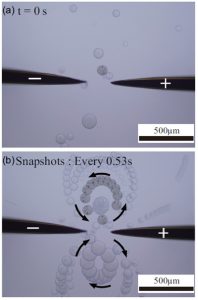DNA直流電圧のもとでのプラスチック粒子の公転運動
直流電圧のもとでのプラスチック粒子の公転運動に関する論文が、国際誌J.Chem.Phys.にアクセプトされました。
界面活性剤を含む油相中,直流定電場下で高分子ミクロ粒子が周期的に公転運動することを見出した(Fig. 1).この運動では1) 電極の直交鉛直方向にずれた位置で二つの渦が同時に起こる2) 油相中の界面活性剤の種類を変える(アニオン性・カチオン性)ことによって公転運動が反転する(Fig. 2) という興味深い特徴がみられた. 回転運動のメカニズムとして,油相中にnmサイズの逆ミセルとして存在している界面活性剤が直流電場を負荷することで電極間に二つのロール状の対流運動を引き起こし,その結果,高分子ミクロ粒子が公転運動していると推定。理論モデルによるシミュレーションにより、メカニズムの妥当性を検証した。
 |
 |
| FIG. 1. Self-revolution of plastic particles. (a) Initial condition at t = 0 s from when DC voltage was applied. (b) Overlap of snapshots every 0.53 s. Multiple polyethylene particles with radii of r = 50 – 175µm rotate in the oil phase with an anionic surfactant at V = 170 V. |
FIG. 2. (a-1, b): Angular velocity and angular acceleration depending on the angular position of the particle in the presence of an anionic surfactant (a-1), or a cationic surfactant (b). (a-2): The blue solid line is the velocity and the red dotted line is the acceleration. Videos of these experiments are shown in the Supplemental Materials.14 The radius of rotation in both the anionic and cationic surfactants depends on the initial position of a particle. Particle size: d=175 µm. Applied voltage: V =170 V and 180 V for (a) and (b), respectively. |


